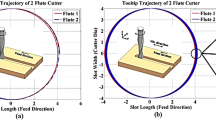Abstract
This article describes an automated control system of the cutting mode where temperature is monitored by a thermocouple. The system is based on a fuzzy algorithm of self-calibration that aims to provide calculation accuracy for the voltage at the transistor control gate, the drain of which is connected to cooling Peltier element. The algorithm operation and total system have been numerically simulated.
Similar content being viewed by others
References
Kumanan, C.P. and Jesuthanam, R., Ashok Kumar application of multiple regression and adaptive neuro fuzzy inference system for the prediction of surface roughness, Int. J. Adv. Manuf. Technol., 2008, vol. 35, nos. 7–8, pp. 778–788.
Firman Ridwan, Xun Xu, and Frederick Churn Loong Ho, Adaptive execution of an NCprogram with feed rate optimization, Int. J. Adv. Manuf. Technol., 2012, vol. 63, nos. 9–12, pp 1117–1130.
Makarov, A.D., Optimizatsiya protsessov rezaniya (Cutting Processes Optimization), Moscow: Mashinostroenie, 1976.
Serov, A.A., Dolaberidze, G.V., Ivanova, M.A., Sokolova, A.G., and Vlasishen, Yu.V., Software for vibroacoustic monitoring of machinery on the basis of an S-discriminant method, J. Mach. Manuf. Reliab., 2012, vol. 41, no. 2, pp. 172–177.
Serkov, N.A, Model of relative position deviations of the executive bodies of a multiaxis machine tool, J. Mach. Manuf. Reliab., 2011, vol. 40, no. 3, pp. 251–260.
Dubrov, D.Yu., The way to increase strength period for turning tools by evaporation cooling under dry cutting, Cand. Sci. (Eng.) Dissertation, Bryansk: Bryansk State Techn. Univ., 2015.
Astashev, V.K. and Korendyasev, G.K, Thermomechanical model of the occurrence of oscillations in metal cutting, J. Mach. Manuf. Reliab., 2012, vol. 41, no. 3, pp. 189–193.
Bobyr’, M.V., Milostnaya, N.A., Yakushev, A.S., and Kulabukhov, S.A., RF Patent 2549811, Byull. Izobret., 2015, no. 12.
Bobyr, M.V., Titov, V.S., and Nasser, A.A, Automation of the cutting-speed control process based on soft fuzzy logic computing, J. Mach. Manuf. Reliab., 2015, vol. 44, no. 7, pp. 633–641.
Titov, V.S., Bobyr’, M.V., and Kulabukhov, S.A., Fuzzy-logic system for controlling stabilization of elements cutting process, Izv. Yugo-Zapad. Gos. Univ., 2013, no. 3, pp. 54–58.
Titov, V.S., Bobyr’, M.V., and Kulabukhov, S.A, The way to consider the inertance phenomena in fuzzy-logic control systems, Pribory Sist., Upravl., Kontrol’, Diagn., 2014, no. 12, pp. 14–19.
Bobyr’, M.V., Kulabukhov, S.A, and Titov, D.V, The way to estimate how the number of tutoring points effects onto fuzzy systems additivity, Prom. ASU Kontrollery, 2014, no. 10, pp. 30–35.
Titov, V.S., Bobyr’, M.V., and Milostnaya, N.A., RF Patent 2288809, Byull. Izobret., 2006, no. 34.
Author information
Authors and Affiliations
Corresponding author
Additional information
Original Russian Text © M.V. Bobyr, S.A. Kulabukhov, 2017, published in Problemy Mashinostroeniya i Nadezhnosti Mashin, 2017, No. 3, pp. 77–83.
About this article
Cite this article
Bobyr, M.V., Kulabukhov, S.A. Simulation of control of temperature mode in cutting area on the basis of fuzzy logic. J. Mach. Manuf. Reliab. 46, 288–295 (2017). https://doi.org/10.3103/S1052618817030049
Received:
Revised:
Published:
Issue Date:
DOI: https://doi.org/10.3103/S1052618817030049




